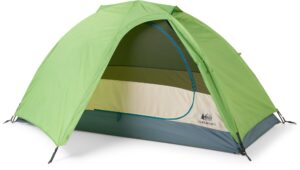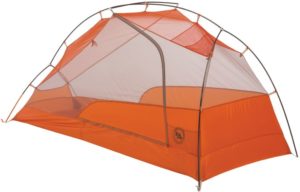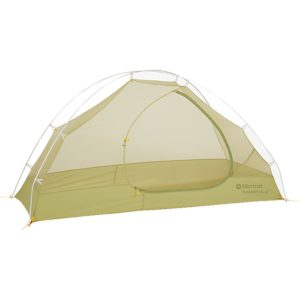There’s nothing quite like backpacking alone. Just imagine trekking through the woods with chirping birds by your side or standing alone on a mountain top with nothing but the sunset to accompany you. These moments will stick with you forever: the trek itself, the people you meet, and most of all, the nights you spend under the stars. To make sure you have a great experience, you need one of the best one man tents for backpacking you can find.
One man backpacking tents can vary considerably in style, size, shape, weight, and functionality. Some are more aerated than others. Others are more durable. Depending on your adventure, you’ll need to decide which style and features will work for you. And once ready, you’ll want to pick the best tent for your needs. Fortunately, we here at The Adventure Junkies have picked out the five best one man backpacking tents available on the market today to make your job easier. Take a read through and see which one you like the best.
For a complete analysis of all backpacking tents, check out the buyer’s guide Best Backpacking Tents.
Quick Answer - The Best One Man Tents for Backpacking
- REI Trailmade 1
- Big Agnes Copper Spur HV UL 1
- Nemo Hornet Elite 1P
- Marmot Tungsten 1P
- The North Face Stormbreak 1
Comparison Table - The Best One Man Backpacking Tents
For the best experience turn your device horizontally| Name | Weight | Floor Area | Height | Price | Rating | Review |
|---|---|---|---|---|---|---|
| REI Trailmade 1 | 5 lbs 01 oz | 22.0 sq ft | 40.0 in | $179 | 4.3 | Read Review |
| Big Agnes Copper Spur HV UL 1 | 2 lbs 08 oz | 20.0 sq ft | 38.0 in | $449 | 4.5 | Read Review |
| Nemo Hornet Elite 1P | 2 lbs 00 oz | 21.0 sq ft | 40.0 in | $549 | 4.5 | Read Review |
| Marmot Tungsten 1P | 3 lbs 12 oz | 20.0 sq ft | 38.0 in | $193 | 4.6 | Read Review |
| The North Face Stormbreak 1 | 3 lbs 07 oz | 18.1 sq ft | 33.5 in | $170 | 4.6 | Read Review |
| Name | Weight | Floor Area | Height | Price | Rating | Review |
Reviews - Best One Man Tents for Backpacking
REI Trailmade 1
Specs
- Floor Area: 22.0 sq ft
- Footprint Included: Yes
- Height: 40.0 in
- Weight: 5 lbs 01 oz
Features
- Dual-stake vestibule (for protection from the elements)
- Vertical sidewalls
- Color-coded for easy assembly
The REI Co-op Trailmade 1 Tent with Footprint is a lightweight, 3-season shelter designed for solo backpackers seeking simplicity and durability. Weighing just 3 lbs. 13 oz., it features a straightforward X-pole setup for quick assembly. The tent includes a footprint to protect the floor, extending its lifespan. Constructed with solution-dyed nylon mesh, it reduces water and energy usage during production, aligning with eco-friendly practices.
As a Climate Neutral Certified product, it reflects REI’s commitment to sustainability. With ample space and reliable protection, the Trailmade 1 ensures comfort and confidence on your solo adventures.
Big Agnes Copper Spur HV UL 1
Specs
- Floor Area: 20.0 sq ft
- Footprint Included: No
- Height: 38.0 in
- Weight: 2 lbs 08 oz
Features
- Storm Flaps (for protection from rain and wind)
- Massive Ceiling Pocket
- Dual-Zipper Door
Hoping to hike for a few years to come and want a tent that’ll keep up with you? The Big Agnes Copper Spur HV UL 1 may have a funny name, but it’s built to perfection for all hikers. From the dual-zipper door to its proprietary ripstop nylon fabric, this tent not only maximizes space, but is built to withstand more serious elements. A plethora of pockets is perfect for the hiker with a bounty of accessories while the outer storm flaps protect your tent from any unwanted damage.
With a 2-tone mesh wall that serves as camouflage in the backcountry, you can take this tent into a camping site with all the privacy you need. And, courtesy of the tent’s stable design, you can also take the Copper Spur 1P alone into the high mountains with confidence. The Copper Spur is by far one of the most versatile and durable tents out there.
Nemo Hornet Elite 1P
Specs
- Floor Area: 21.0 sq ft
- Footprint Included: No
- Height: 40.0 in
- Weight: 2 lbs 00 oz
Features
- Ultralight Design
- Single, Durable, Aluminum Pole
- Large Side Door
Small, sleek and streamlined, the Nemo Hornet 1P looks a lot like its name. A unique design boasts ample floor space while triangulated guy outs, or anchor points, create a tall ceiling. As you hike, you may not even feel the Hornet’s super light aluminum pole in your bag. And when you arrive, the singular pole design means you can assemble your tent within seconds.
Whether you intend on forest camping or section-hiking on The Appalachian or Pacific Crest Trail, this tent may be the perfect option for you. If you like the design, you can even find a lighter tent in the Nemo Hornet Ultralight version.
Marmot Tungsten 1P
Specs
- Floor Area: 20.0 sq ft
- Footprint Included: Yes
- Height: 38.0 in
- Weight: 3 lbs 12 oz
Features
- Vertical Interior Walls
- Color Coded Assembly
- Lampshade Pocket (a pocket inside that holds a headlamp)
Built for comfort, the Marmot Tungsten 1P has more space than other one person tents on the market. Straight edge floors and vertical interior walls let your body breathe while several well-placed vents keep you cool. The unique lampshade pocket within can hold a small light or headlamp allowing you to read, write or organize your belongings without trouble.
The Marmot Tungsten may be a bit heavier than other one person tents, but the added floorspace and included footprint (a small pad placed underneath your tent to protect its underside from abrasions) make this tent a durable and comfortable bet for any adventure into the outback.
The North Face Stormbreak 1
Specs
- Floor Area: 18.1 sq ft
- Footprint Included: No
- Height: 33.5 in
- Weight: 3 lbs 07 oz
Features
- Easy-Pitch Design (easy-to-assemble structure)
- High and Low Ventilation (for maximum airflow to keep you cool)
- Seam-Taped Canopy and Floor (secured seams throughout the tent to prevent leakage)
The North Face Stormbreak 1 is an affordable option for the minimalist hiker. Built especially to protect you from the elements, the Stormbreak provides sufficient space and ventilation. The easy-pitch design takes only minutes to assemble while its freestanding nature means you don’t need to pack along any tent stakes to anchor it to the ground. The low cost of the North Face Stormbreak makes it a great option for any hiker with little to bring on their trip.
THINGS TO CONSIDER WHEN BUYING ONE MAN BACKPACKING TENTS
Choosing a backpacking tent can be an overwhelming process — reading through the features and deciding which one’s matter most is time-consuming and can be confusing. We’ve provided you with our top considerations for buying a one man backpacking tent, and if you want even more information, make sure to read through REI’s handy guide about how to choose a backpacking tent.
SPACE
One man backpacking tents don’t differ much on their size, but even the slightest variation can change your experience completely. When picking out a backpacking tent, make sure you compare your body size to the size of the tent. Do you need a lot of room at night to read? Or do you simply want to crawl into bed and pass out? Preference is everything when you’re alone in the outback so make sure you have ample room to enjoy your night.
VERSATILITY
Whenever you buy a tent, you’ll want to take a look at all its features. Some tents are better equipped for the elements, whereas others may pose a better option for casual camping. You’ll also want to factor in its storage capacity and your personal needs. If you’re heading out on a long trip, you may have a stove and other accessories you need to store for the night, whereas if you’re camping out of your car or in the backyard, you won’t need as much internal storage space.
COST
Tents cost a lot of money. There’s no denying that. But some cost a lot more than others. If you’re planning on just a trip or two a year, a cheaper model may be the best bet for you. But if you’re intending to head out on a long expedition, the more money you spend, the more reliable your equipment. Gauge your intentions, and then spend the money to match them. The last thing you want after a long day’s hike is a broken cheap tent.
FOOTPRINT
A footprint, or cloth you place under your tent to protect it from ground, may or may not be included with your tent. Make sure you pay attention to whether or not a footprint is included because, depending on your intentions, you may need a footprint to ensure your tent’s survival. We suggest that long-term, mild campers purchase a footprint as it will improve the life expectancy of your tent. Backcountry campers, who carry all their gear on their back for miles on-end, may not want the added weight of a footprint, so it may not be necessary to include with the purchase of the tent.
WEIGHT
A pound or two could make the difference between a sore back or not while you’re hiking many miles each day. When buying your tent, check its weight and think about how long you intend to carry it. If a ten mile hike every day is in your mind, you’ll want something lighter to carry. Otherwise, a few pounds won’t affect you too drastically if you have a short day-hike in mind or are planning on car camping.
FEATURES EXPLAINED
Footprint
A cloth placed beneath the tent floor to protect it from the ground.
Freestanding
A tent capable of standing without the need for tent stakes.
Guyout
Sturdy loops or anchor points used to secure your tent or form its structure without poles.
Vertical walls
As opposed to tilted walls, vertical walls provide more internal space for campers.
Tent canopy
Either integrated or not, the tent canopy serves as the roof of a tent.
READ MORE
For more of our top hiking & backpacking gear recommendations, check out these popular buyer's guides:
Best Backpacking Sleeping Bags
Best Backpacking Sleeping Pads





